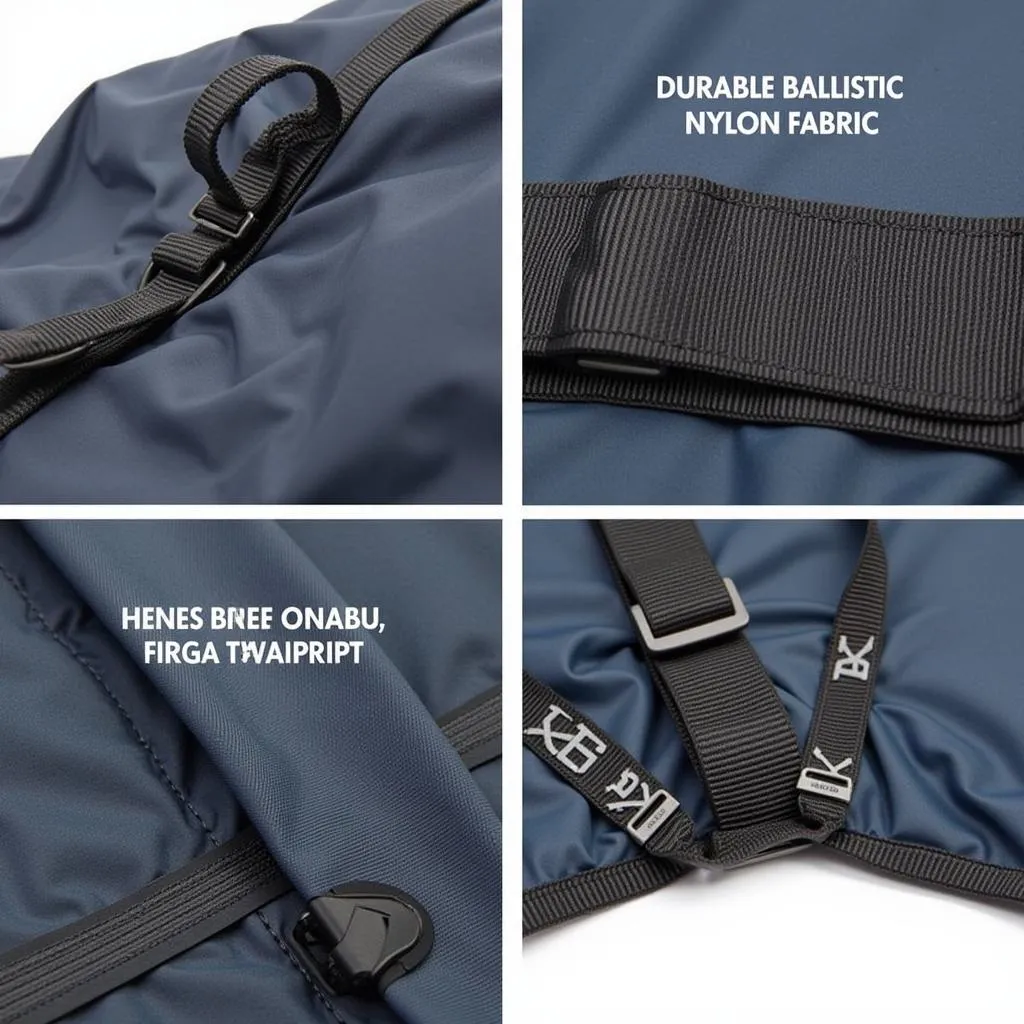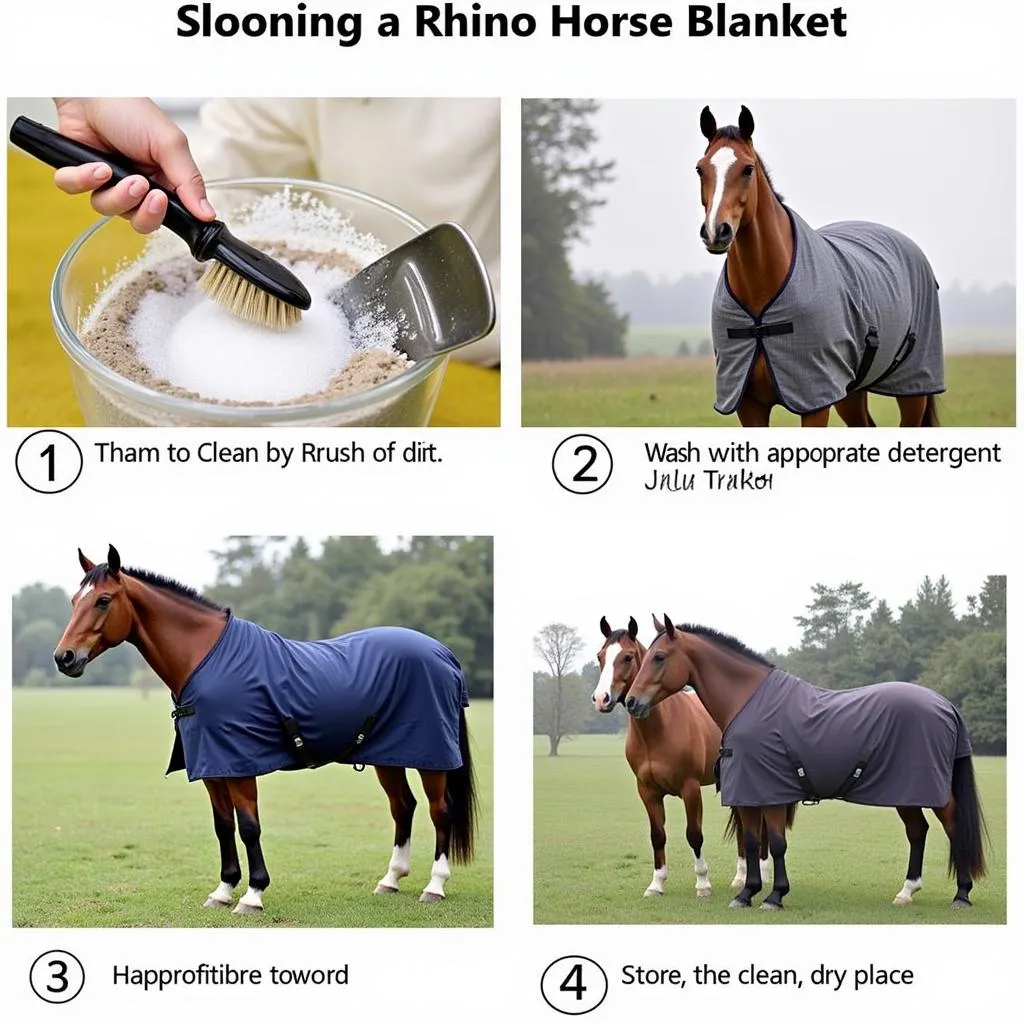Rhino Horse Blankets have earned a reputation for their durability and effectiveness in protecting horses from the elements. But with so many options available, choosing the right blanket for your equine companion can feel overwhelming. This comprehensive guide will delve into everything you need to know about Rhino horse blankets, helping you make informed decisions to ensure your horse stays comfortable and healthy all year round.
Understanding the Importance of Horse Blankets
Before we explore the specifics of Rhino horse blankets, let’s understand why blanketing horses is essential. Horses, despite their hardy appearance, are susceptible to cold, wind, and rain. Blankets provide an extra layer of warmth and protection, helping them regulate their body temperature and stay comfortable in various weather conditions.
Why Choose Rhino Horse Blankets?
Rhino horse blankets stand out for their exceptional quality and thoughtful design. Here’s what makes them a top choice for horse owners:
- Durability: Crafted from robust materials like ballistic nylon and ripstop fabrics, Rhino blankets are built to withstand the rigors of stable life and outdoor activities.
- Weather Resistance: Featuring waterproof and windproof outer layers, these blankets effectively shield your horse from rain, snow, and chilly winds.
- Breathability: Despite their weatherproof properties, Rhino blankets prioritize breathability. They allow for proper air circulation, preventing your horse from overheating or feeling clammy beneath the blanket.
- Comfort and Fit: Designed with the horse’s anatomy in mind, Rhino blankets offer a secure and comfortable fit. Features like adjustable chest straps, leg straps, and tail flaps ensure the blanket stays in place, preventing slippage and discomfort.
 Rhino Horse Blanket Durability
Rhino Horse Blanket Durability
Types of Rhino Horse Blankets
Rhino offers a diverse range of horse blankets to cater to varying needs and climates. Let’s explore the most common types:
Turnout Blankets:
Designed for horses spending time outdoors, turnout blankets provide protection from rain, wind, and low temperatures. They often feature a waterproof and breathable outer layer with varying degrees of insulation, measured in grams.
Stable Blankets:
Ideal for horses stabled during colder months, stable blankets provide warmth in a controlled environment. They are typically lighter than turnout blankets and offer varying insulation levels to suit different temperature ranges.
Fly Sheets:
These lightweight, uninsulated blankets shield horses from pesky insects during warmer months. They are often made from breathable mesh materials that allow for airflow while keeping flies and other bugs at bay.
Coolers:
Designed to wick away moisture and prevent chills after exercise, coolers are made from breathable fabrics that help regulate the horse’s body temperature. They are particularly useful during cooler weather or when transporting a horse after a workout.
Choosing the Right Rhino Horse Blanket: Factors to Consider
Selecting the appropriate Rhino horse blanket for your companion requires careful consideration of several factors:
1. Climate and Temperature:
- Cold Climates: Opt for turnout blankets with higher gram insulation (200g and above) for horses living in regions with harsh winters. Stable blankets with varying insulation levels can provide additional warmth during colder months.
- Mild Climates: Horses in milder climates may only require lightweight turnout blankets (0g to 100g) for protection from wind and rain.
- Summer Months: Breathable fly sheets are ideal for keeping horses comfortable and insect-free during warmer seasons.
2. Horse’s Coat and Condition:
- Horses with Thick Winter Coats: May need lighter blankets compared to those with thinner coats. Observe your horse’s body temperature and adjust blanketing accordingly.
- Clipped Horses: Require warmer blankets as their natural insulation is reduced.
- Older or Unhealthy Horses: May need extra warmth and protection, especially during colder months.
 Choosing Rhino Horse Blankets for Different Climates
Choosing Rhino Horse Blankets for Different Climates
3. Activity Level and Lifestyle:
- Horses in Work: May need lighter blankets or coolers after exercise to regulate body temperature.
- Horses Turned Out 24/7: Require durable turnout blankets that can withstand constant wear and tear.
- Horses Stabled at Night: Benefit from comfortable and warm stable blankets during colder months.
4. Blanket Fit and Features:
- Proper Fit: A well-fitting blanket is crucial for comfort and safety. Consider your horse’s size, breed, and body shape when choosing a blanket.
- Adjustable Features: Look for blankets with adjustable chest straps, leg straps, and surcingles to ensure a secure and customizable fit.
- Lining and Fill: Rhino blankets offer a variety of linings and fill options. Consider factors like your horse’s sensitivity and the climate when making a choice.
Caring for Your Rhino Horse Blanket
Proper care can significantly extend the lifespan of your Rhino horse blanket. Follow these tips to keep it in optimal condition:
- Regular Cleaning: Remove dirt and debris regularly using a brush or vacuum. Wash the blanket according to the manufacturer’s instructions, typically a few times per season.
- Proper Drying: Allow the blanket to dry completely after washing, preferably in a well-ventilated area or outdoors on a sunny day.
- Storage: Store clean and dry blankets in a cool, dry place during the off-season.
- Inspect Regularly: Check for any signs of wear and tear, such as rips, loose stitching, or broken hardware. Repair any damages promptly to prevent further issues.
 Caring for Rhino Horse Blanket
Caring for Rhino Horse Blanket
Conclusion
Investing in a high-quality Rhino horse blanket is a wise decision for any horse owner committed to providing their equine partner with optimal comfort and protection from the elements. By understanding the different types of blankets, considering your horse’s individual needs, and prioritizing proper care, you can ensure your Rhino blanket provides years of reliable service, keeping your cherished companion warm, dry, and content.
FAQs
Q: How do I determine the correct blanket size for my horse?
A: Measure your horse from the center of the chest, across the point of the shoulder, to the point of the buttock. This measurement in inches will correspond to the blanket size.
Q: Can I leave my horse blanketed 24/7?
A: It’s generally not advisable to leave a horse blanketed 24/7. Allow your horse periods without a blanket, especially during milder weather, to prevent overheating and promote natural coat health.
Q: How often should I wash my horse’s blanket?
A: It’s recommended to wash your horse’s blanket several times per season, or more frequently if it becomes excessively soiled.
Q: Can I use a turnout blanket as a stable blanket?
A: While you can use a turnout blanket as a stable blanket, keep in mind that turnout blankets are generally bulkier and may be too warm for indoor use, especially if your stable is well-insulated.
Q: My horse tends to destroy blankets. Will a Rhino blanket hold up?
A: Rhino blankets are known for their exceptional durability, crafted from tough materials designed to withstand wear and tear. However, no blanket is completely indestructible.
Need assistance in choosing the perfect Rhino horse blanket for your equine partner?
Contact our expert team at:
Phone Number: 0772127271
Email: [email protected]
Or visit us at: QGM2+WX2, Vị Trung, Vị Thuỷ, Hậu Giang, Việt Nam.
We offer 24/7 customer support to answer your questions and guide you toward the ideal blanket for your horse’s needs.